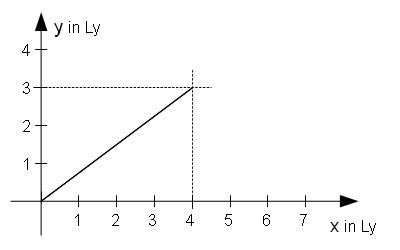 | ||
Stellar aberration is an astronomical phenomenon "which produces an apparent motion of celestial objects". It can be proven mathematically that stellar aberration is due to the change of the astronomer's inertial frame of reference. The formula is derived with the use of Lorentz transformation of the star's coordinates.
Contents
- Derivation of the formula for motion along the x axis
- Approximate formula for motion along the x axis in case of vc 1
- Symmetric form of the exact formula for motion along the x axis
- Formula for motion along the y axis
- Formula for motion along a ray lying in the x y plane with direction vector cos sin
- Application Aberration in astronomy
- Stellar aberration due to the orbit of Earth around the Sun
- Stellar aberration due to Earths rotation
- Stellar aberration due the orbit of our solar system around the center of the Milky Way
- References
As the astronomer John Herschel has already explained in 1844, the stellar aberration does not depend on the relative velocity of the star towards Earth. Otherwise eclipsing binary stars would appear to be separated, in stark contrast to observation: both stars are rotating with high speed —and ever changing and different velocity vectors— around each other, but they appear as one spot all the time.
Derivation of the formula for motion along the x-axis
For the derivation it is assumed, that the light signal only travels through space regions where the gravitation field is negligible. Hence is suffices to use special relativity and the path of the light signal is a straight line in any inertial frame of reference.
Observation in the rest frame S of the center of mass of our Solar System
The rest frame of the center of mass (barycenter) is a very good quasi-inertial frame of reference for periods of time in the order of thousands of years, since our solar system needs about 230 million years (galactic year) to move completely around the center of the Milky Way. The space coordinates of this frame of reference form a Cartesian coordinate system.
In the reference frame S
In reference frame S the light signal starts at
In S the path of the light signal is a straight line and it forms an angle
Observation in the inertial frame of reference S' which is in uniform motion (relative to S) along the x-axis
The origin of the reference frame S' is in uniform motion relative to S with
S' now is an equally good quasi-inertial frame of reference as S: the space coordinates form a Cartesian coordinate system and the path of the light signal is a straight line.
According to the Lorentz transformation one gets:
In reference frame S' the light signal starts at
In S' the path of the light signal is a straight line, too. It forms an angle
Hence:
These are the same formulas as in aberration of light#Explanation.
Approximate formula for motion along the x-axis in case of v/c <<1
Case I:
As Δδ<<1 one gets:
As β<<1 one gets:
Therefore
Case IIa:
and therefore:
Case IIb:
Hence:
Conclusion:The change of the angle Δδ = δ'-δ in the case of β = v/c << 1 can be described by the approximate formula
Symmetric form of the (exact) formula for motion along the x-axis
With help of tangent half-angle formula
And as
Formula for motion along the y-axis
Let
Hence:
The symmetric form is:
As
Since
And the symmetric form is:
And as
Formula for motion along a ray lying in the x-y-plane with direction vector (cos α | sin α)
With the same reasoning as above one gets the formula:
The symmetric form is:
The approximate formula is:
Application: Aberration in astronomy
The stellar aberration is purely an effect of the change of the reference frame. The astronomer orbits (with Earth) around the Sun and furthermore rotates around the axis of Earth. His current rest frame S' therefore has different velocities relative to the rest frame S of the barycenter of the Solar System at different times. Hence the astronomer observes that the position of the star changes. The formula is derived under the condition that the change of the position of the star and of Earth is negligible in the period of observation. That is correct for almost all stars: the amplitude of the parallax of a star, for a distance of ≥ n parsec, is ≤ 1/n ".
Stellar aberration due to the orbit of Earth (around the Sun)
The mean orbital speed of Earth is
->
Stellar aberration due to Earth's rotation
An astronomer at the latitude
Stellar aberration due the orbit of our solar system around the center of the Milky Way
The rest frame of the center of mass of our solar system isn't a perfect inertial frame of reference since our solar system orbits around the center of the Milky Way. An estimation for the time of period of circulation is 230 million years (estimations vary between 225 and 250 million years). As the estimation for the distance between our solar system and the center of the Milky Way is about 28000 Ly, the assumed orbital speed of our solar system is
